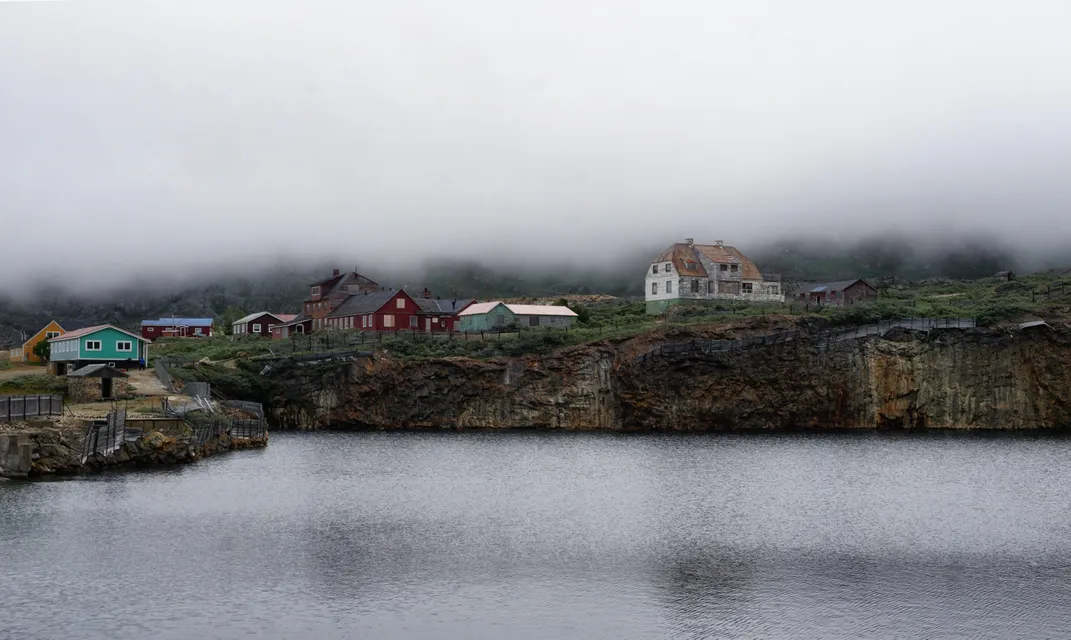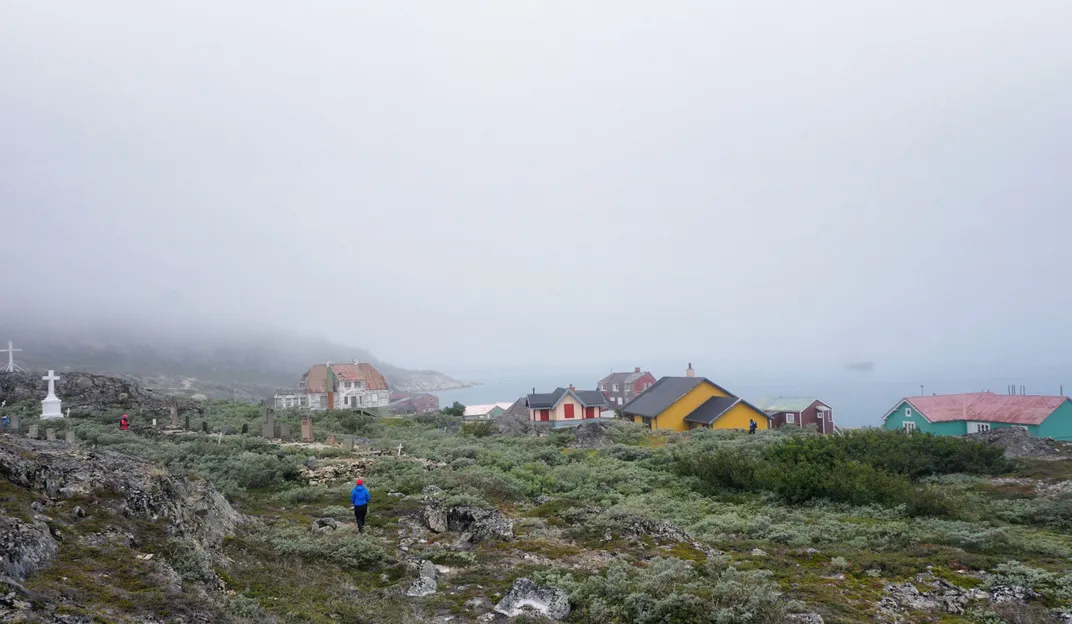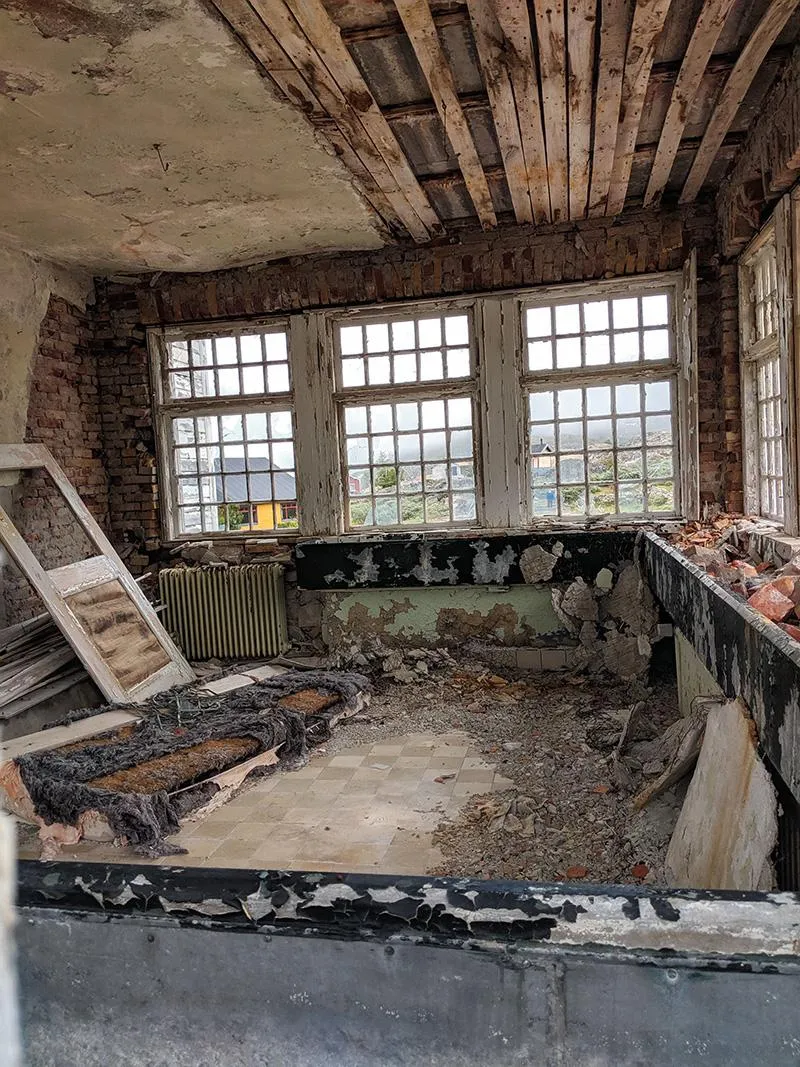How This Abandoned Mining Town in Greenland Helped Win World War II
Ivittuut held the world’s largest reserve of naturally occurring cryolite, a mineral that was used in the manufacturing of fighter planes
/https://tf-cmsv2-smithsonianmag-media.s3.amazonaws.com/filer/54/05/54053ff6-5125-4b5a-b769-59c56f391054/ivittuut_main.jpg)
It was a foggy morning in south Greenland as I stood on deck and peered at the mountains poking through the clouds. Our Adventure Canada expedition ship docked offshore, and we disembarked on Zodiac boats to what looked like a ghost town.
Scattered on the rocky shore were little white chunks of cryolite, a mineral once used in the production of aluminum. As the mist swept through the empty houses dotting the shorelines, we walked up to the mine—a pit spanning 755 feet long and 656 feet wide—and looked over at a glassy, water-filled bottom. Meandering through the abandoned mining town, relics of the past—old engines and bottles—mixed with fresh tire tracks and cigarette butts left by musk ox hunters passing through the area.
Founded in 1854, the town of Ivittuut (formerly Ivigtut) once held the world’s largest reserve of naturally occurring cryolite. The Inuits, who liked to camp there during the summers, had long known about cryolite, which they would add to their snuff or tobacco. “In the beginning of the 18th century, there were samples of cryolite sent to Copenhagen, probably by a German named Karl Ludwig Giesecke, an employee of The Royal Greenland Trading Department (KGH) owned by Denmark,” says Peter Barfoed, a former Ivittuut resident who now lives and works as an architect in Greenland's capital Nuuk. After Danish chemist Julius Thomsen patented a method to separate cryolite into soda in 1853, demand increased and mining production began the next year. According to The History of the Cryolite Industry 1847 – 1990, the mine reached its peak level of production in 1942 when 86,000 tons were shipped to the United States and Canada for aluminum production. Then again in 1985, right before the mine closed, shipment spiked to 110,000 tons.

Today, Ivittuut’s deserted buildings, massive cryolite hole and above-ground cemetery are popular sights for expedition ships cruising Greenland. As with most places in Greenland, a boat is the fastest and easiest way to reach this historic site, as there are no roads connecting the vast country.
After the Nazis occupied Denmark in 1940 and America got involved in World War II in 1941, Ivittuut became a crucial site in the fight. Though Denmark operated the mine since 1854, the United States protected it during the war so that the Allies could mine the cryolite for use in fighter plane manufacturing. It was such a key site during the war, explains Barfoed, that around 500 U.S. soldiers guarded the mine and its 100 to 200 miners from the Nazis.
“There were big guns placed in strategic points ready to shoot German submarines,” he says. “The first gun was placed in September 1940, long before the U.S. was officially involved in World War II.” The U.S. Navy also built a naval base three miles away in Kangilinnguit, formerly called Grønnedal, and the U.S. Coast Guard built a base across the fjord from Ivittuut, holding hundreds more soldiers. According to Barfoed, during the 1940s, the majority of the cryolite was shipped to Philadelphia, Pennsylvania, to a company called Pennsylvania Salt Manufacturing Company or Pennsalt, where it was refined to be used in the production of aluminum.

If the Nazis were to get ahold of this critical resource, it would have been damaging to the Allies. “Without it, the Allied forces would not be able to win the Battle of Britain and bomb Germany,” says Rie Oldenburg, a historian and head of education at Campus Kujalleq, a school in Qaqortoq, Greenland. To protect its location, no photographs of Ivittuut were allowed to be taken during the war, and no one was allowed to write letters to family or friends for fear that the Germans would intercept them.
The miners were a mix of foreigners, including Danish, Canadians and Americans, Barfoed explains, while indigenous Greenlanders labored in the kitchen. According to him, many local women also worked as nannies and housekeepers in private homes. By the time the site officially closed around 1987, Barfoed says more Greenlanders were working in the mine.
When I was exploring Ivittuut, I asked local Inuit about what it was like during the war and their relationship with Americans. They declined to answer, fearful that their responses would reflect poorly on the United States at a time when President Trump has focused his attention on their island nation. One local remembered watching a program on Kalaallit Nunaata Radioa (KNR), a public television station in Greenland, about four children from the nearby town of Arsuk being taken at gunpoint by American soldiers. They were eventually rescued, but the incident created mistrust between Greenlanders and Americans.
After the war, Denmark continued to mine the mineral until the site closed around 1987, and American influences lingered. “Culture in Greenland was Americanized: music, dancing, fashion. Greenland also became part of the Western hemisphere and part of the American defense system during the Cold War,” says Oldenburg. “The American influence has been huge, but not always visible to the Greenlanders, who were not included in the decisions.”
Curiously, American soldiers left behind something that would shape modern Greenland—Sears, Roebuck and Company catalogs. This allowed Inuits and Danish inhabitants to order name brand appliances, like General Electric stoves and refrigerators and boats that modernized the way of life in Greenland.
Barfoed remembers sailing from Copenhagen to Ivittuut with his family in 1952. His father worked for the Danish cryolite mining company in control of operations in Ivittuut, called Kryolitselskabet Øresund. He recalls seeing Sears, Roebuck postorder catalogs, and the next year for Christmas, he got his first electric train, an American Flyer.

Today, Ivittuut’s main draw is tourism; around seven buildings are still in good shape with newly painted exteriors. A small, yellow house with blue trim and a red door used to be a clubhouse for the town’s tennis court. Next door, a green building stands that was once the mine’s office and a yellow building that was once a hospital. Today, the former hospital serves as accommodation for anyone passing through or looking to stay in the town on a hunting trip.
One of the most fascinating buildings is a large, dilapidated home where the head of the mine used to live called Slottet, or “The Castle,” in Danish. In its heydey, it was a stately, white building with natural light beaming in from the glass windows and a stunning fireplace said to have been designed by Finn Juhl, a famous architect and brother of former mine boss Erik Juhl. Today, you can look inside and see rubble, smashed tiles and doors off their hinges.
During the war, American soldiers lived in barracks near the mine. Barfoed recalls playing in the then-abandoned buildings, which are now no longer standing, many years ago when they were used as storage for engines, furniture and beer.
Around 500 feet from the mine is a beautiful lake, a water intake for Ivittuut, where tourists can walk and spot wild musk ox. Travelers can also wander around the small cemetery, which is above-ground due to rock just below the surface and a lack of soil. On top of the hill overlooking the town is a large white anchor acting as a memorial to those lost at sea. A bronze plate near it is dedicated to the hundreds killed aboard the American SS Dorchester. While on its way to Ivittuut in 1943, the ship was shot and sunk by a German U-boat.
Visitors to Ivittuut are encouraged to act respectfully, not to enter the homes and to cause as little damage as possible to the fragile structures.
“It is a crown jewel of Greenland,” says Barfoed.
Planning Your Next Trip?
Explore great travel deals
Smithsonian magazine participates in affiliate link advertising programs. If you purchase an item through these links, we receive a commission.